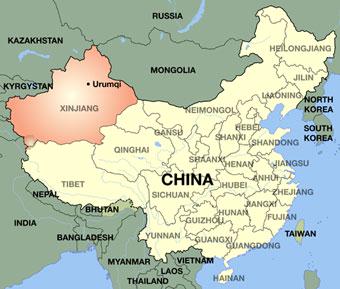1. The general history of Christianity in XinJiang before the 19th century.
The earliest document of the Christian preaching activities in XinJiang before 19th century goes back to the first half of 6th century. In this long historical periods, the main preaching mode was through Nestorianism in XinJiang area, and under the remote control of East Syria Church (Nestorian Head Quarter) the preaching radiated the whole west and middle Mongolian grassland, and the north area of China (BeiJing to the east, Yellow River area to the south).
In the Mongol Empire period, not only XinJiang area but the Yuan dynasty China was influenced by the Mongol royalty, so Nestorianism prevailed widely. When the Uygur Nestorian MaKaoSi was elected as the Nestorian Archbishop he brought Nestorianism to its top in history. At the same time, there were a few Catholics preaching activities in northwest XinJiang. The Islamization in XinJiang area was completed by Mongolia East Chagatai Khanate at the end of 14th century. In the beginning of 16th century, the force of China Ming dynasty dropped out east XinJiang, and the Gelugpa Lamaism prevailed over Zhungeer Empire Mongolians of north XinJiang. Except for Islamism, there were no other religions in public at XinJiang area in the middle of 18th century.
2. Christianity history in XinJiang from the end of 19th to the first half of 20th century
The following is a brief introduction to the preaching history of Swedish Covenant Missionary Church(瑞典圣约宣教教会) and China Inland Mission. The Swedish preaching achieved grand success in south XinJiang. From 1892 to 1938 (when the last three missionaries were forced to leave), missionaries sent out by this church worked 46 hard years and converted over 300 local Turki to Christians, founded the first Turki church, nurtured over 30 local Turki and Han church staff and an Uygur preacher Ali.
The China Inland Mission was the first preaching group that entered XinJiang, and its main work was done in Urumqi area of the east by north XinJiang. Since Dr. Henry Lansdell, a member of the British and Foreign Bible Society and the Royal Geographical Society, and George Park from the China Inland Mission had entered XinJiang, the preaching work began.
Until the last three British missionaries of the Urumqi office of China Inland Mission were banished, the preaching work lasted for half a century, which was hard and slow, yet very much accomplished. Besides, in 1886, missionaries for Holland and Poland Catholic church went Kashgar to preach, 6 years earlier than the Swedish, 10 years later than the British.
In 1892, Swedish missionaries came to Kashgar for investigation before preaching. After the disappearance of Christianity in XinJiang for 500 years, the first Christian missionary came here was a Turkish named John Avitalynia, who started a very important work to translate the New Testament to what he referred as Kashgarish, which actually was East Turkish (Uygur language), a kind of ancient Uygur language. 2 and half years later, when Swedish preaching group arrived at Kashgar to begin their preaching, John Avitalynia has finished the translation for and . In 1898, the Uygur version of 4 Gospels were printed and issued, and brought to Kashgar. The translation for the New Testament was completed in 1914, and later the Uygur version was printed and issued.
The CIM founded by James Hudson Taylor already had its preaching plan for XinJiang province, as a part for their general plan "Forward Movement". According to the plan, male missionaries would enter XinJiang first, while the female would stop at GanSu to pass the test before going to XinJiang.
In 1876, 16 years earlier than Swedish missionaries, Dr. Lansdell from the British and Foreign Bible Society and the Royal Geographical Society, and George Park from the CIM entered XinJiang, to investigate provincial-widely, and give out or sell Christian reading materials along their patrols. In 1905, CIM sent Mr. Hu JingJie to build a preaching station at the capital DiHua (today's Urumqi).
In 1914, CIM sent out British missionaries Alice Mildred Cable, Francesca French and her sister Evangeline French, the only three female missionaries who ever got to XinJiang for preaching. On November 1932, CIM sent another 6 missionaries to Urumqi to help out the preaching work, but the war broke out shortly after, and Urumqi was in battle. In 1938, the preaching work of CIM in XinJiang had to fully stop.
3. Christianity history in XinJiang of the last half of 20th century
(1) Chinese Back to Jerusalem Evangelist's Band (1943, ShanXi FengXiang):
On January 1941, CIM, the Methodist Church, and some Chinese churches worked together to found the North West Holy Bible School in FengXiang County, over 100 miles west to XiAn, on the purpose to preach Christianity in Islamic area. On the morning of Easter Day 1943, 8 of 70 teachers and students from the North West Holy Bible School were called to preach in XinJiang. Then weekly prayer meetings were host every Tuesday night for frontier preaching. On May 23th, the Chinese Back to Jerusalem Evangelist's Band was officially founded, with Mark as the band leader, and the chief editor of . The main purpose of the band was to preach to 7 provinces and 7 countries in northwest area. Starting from the northwest, along the Silk Road, they would travel through Afghanistan, Iran, Arab, Iraq, Syria, Turkey, Palestine and other Islamic countries, and bring Gospel back to Jerusalem. Due to the civil war in 1948, Mark and 15 Chinese and foreign fellow workers moved to ChongQing. After the change of government of XinJiang in 1950, their work stopped.
(2) The Northwest Spiritual Movement (西北灵工团 ) (1946, ShanDong Wei County)
Zhang GuQuan, born in 1919, after graduating from the North China Seminary of ShanDong Teng County in 1945 he traveled along north and northwest china to preach Gospel and train holy workers, and founded a Spiritual Institute with Li ShiYing in ShanDong Wei County, which had over 40 students, Bible study everyday, and they shared everything. Many of the students came from "Jesus Family", which Zhang GuQuan himself was also under great influence of, and advocated giving out wealth, helping out the poor, self-denying and obeying the Lord.
In 1948, when the school was prayer fasting, the Holy Spirit moved Zhang GuQuan to give up the Spiritual Institute and take all the teachers, students and their families to leave their hometown for XinJiang. So the Northwest Spiritual Group went to XinJiang Hami, at the total number of 115. Since 1951, because of the internal and external conflicts, their work was put to an end. At the end of 1970s, some staff of the Spiritual Group started family gatherings in XinJiang, and the vision, the calling to preach back to Jerusalem were lit up again. Until now, a few people from the original staff of the group are still continuing their work in the northwest frontier area.
(The writer is a preacher in a church of XinJiang.)










